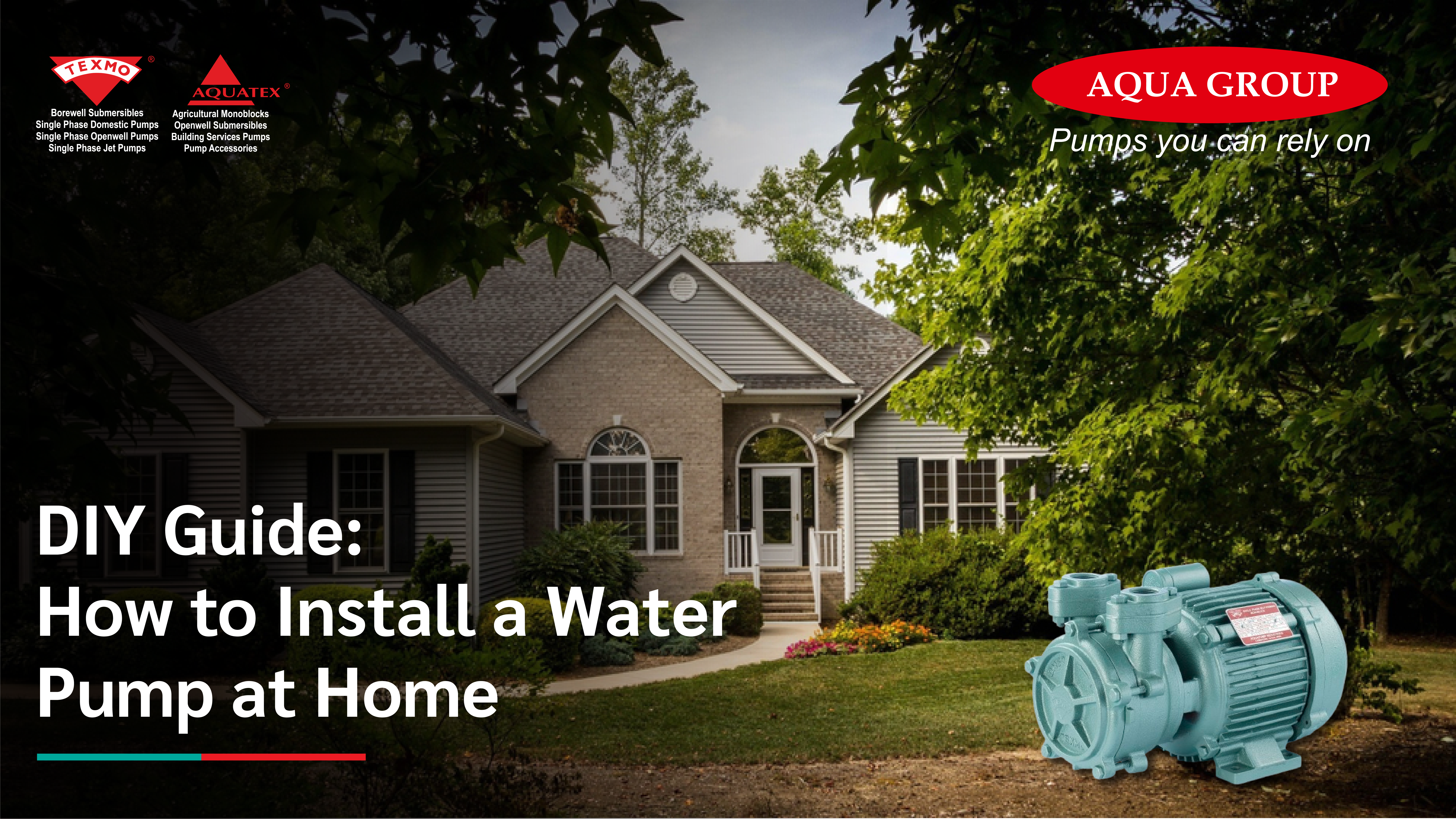
DIY Guide: How to Install a Water Pump at Home
25-04-2025
Installing a water pump at home may sound like a complex task best left to professionals, but with the right guidance, tools, and safety precautions, homeowners can confidently handle basic installations. Whether you’re setting up a pump to draw water from a borewell, increase pressure in the house, or supply water to an overhead tank, understanding the installation process can save you time, money and avoid unnecessary downtime.
This guide from Aqua Group, a trusted name in water pump manufacturing, walks you through the essentials of installing a domestic water pump at home. While we always recommend consulting a certified technician for complex plumbing or electrical tasks, this DIY guide is perfect for simple residential installations or maintenance checks.
Step 1: Choose the Right Pump
Before you begin, ensure that the water pump you’ve selected is suitable for your application. Domestic water pumps from Aqua Group, such as the DMS Series, ACS Series, and Booster Pumps, are designed for a variety of uses, including overhead tank filling, garden irrigation, kitchen and bathroom water pressure improvement, and more. Refer to the product specifications or consult our team to choose a model based on:
- Source of water (open well, borewell, or sump)
- Required head height (vertical distance from source to outlet)
- Flow rate needs
- Distance between source and outlet
- Type of liquid being pumped (clean water or water with particles)
Step 2: Gather Tools and Materials
Here are the basic tools and materials you will need:
- Water pump (suitable for your application)
- Inlet and outlet pipes (PVC or GI, depending on the pump type)
- Control panel (especially for borewell or pressure pumps)
- A pipe wrench or spanner
- Teflon tape
- Non-return valve (foot valve for suction side, check valve for delivery side)
- Electrical wiring (as per load specifications)
- Clamps or fasteners to secure pipes
- Pipe joint compound or sealant
Ensure you switch off the main electrical supply before you begin work.
Step 3: Positioning the Pump
Placement plays a critical role in efficient pump operation. Install the pump as close as possible to the water source to reduce suction losses and energy consumption. For borewell and openwell pumps, the pump must remain fully submerged in water, while monoblock pumps should be installed in a dry, well-ventilated area near the water source to ensure proper operation and prevent dry running.
Ensure the pump is on a level, vibration-free base. Use a rubber pad or anti-vibration mount if necessary. For booster pumps inside homes, install them where noise won’t be a concern, such as near the utility area or basement.
Step 4: Piping Connections
Connect the suction pipe from the water source to the pump’s inlet. Make sure it is airtight; any leaks in the suction line will affect the pump’s ability to draw water. A strainer is highly recommended at the end of the suction pipe for self-priming models.
Connect the discharge pipe from the pump’s outlet to the desired delivery point. Use Teflon tape and proper sealing methods to prevent leaks. For booster or pressure pumps, ensure the discharge is connected to the pressure tank or the pipeline feeding into your house.
It is also advisable to use a non-return valve on the discharge side to avoid backflow and protect the pump during shutdown.
Step 5: Electrical Setup
Connect the water pump to the power source through an appropriate control panel or starter, especially if you’re using single-phase or three-phase motors. For home use, Aqua Group offers compact and efficient control panels that prevent motor burn-out, offer overload protection, and enhance energy efficiency.
Ensure that the wiring is done with the correct gauge wire and that the earthing is proper. Do not use extension cords or under-rated cables for pump installation. If in doubt, get the electrical part done by a qualified electrician.
Step 6: Priming and Testing
Priming the pump is crucial, especially for centrifugal models. Open the priming port and fill the pump casing with water before starting. For submersible or jet pumps, priming may not be required.
Switch on the power and observe the operation. Within a few seconds, water should begin flowing steadily from the outlet. Check for the following:
- Unusual noise or vibration
- Leakage at joints
- Consistent pressure and flow
- Proper switching on/off cycles (for pressure pumps)
If any issues arise, turn off the pump and inspect the connections. Tighten or reseal any loose joints.
Maintenance Tips for Longer Life
Once installed, regular maintenance ensures longevity and optimal performance of your water pump:
- Clean filters or strainers regularly to prevent clogging.
- Check for any leaks or unusual noises regularly.
- Lubricate bearings as recommended by the manufacturer.
- Test the control panel for proper operation.
- If the pump is unused for a long time, store it dry and covered to prevent rust or corrosion.
Aqua Group also offers stainless steel pumps that provide longer service life in areas with corrosive water conditions, ideal for homes with hard water or coastal environments.
Aqua Group: Powering Water Access for Every Home
With decades of expertise in designing and manufacturing water pumps for diverse needs, Aqua Group ensures reliable performance, energy efficiency, and robust after-sales support. Whether you’re setting up a domestic pressure booster or a pump for your borewell, our wide product range under Aqua Group offers solutions for every household.
Our pumps are backed by ISI certification, durable construction, and expert engineering, giving you peace of mind for every drop of water you pump.
For more guidance on installation or choosing the right product for your needs, visit www.aquagroup.in or connect with us.
